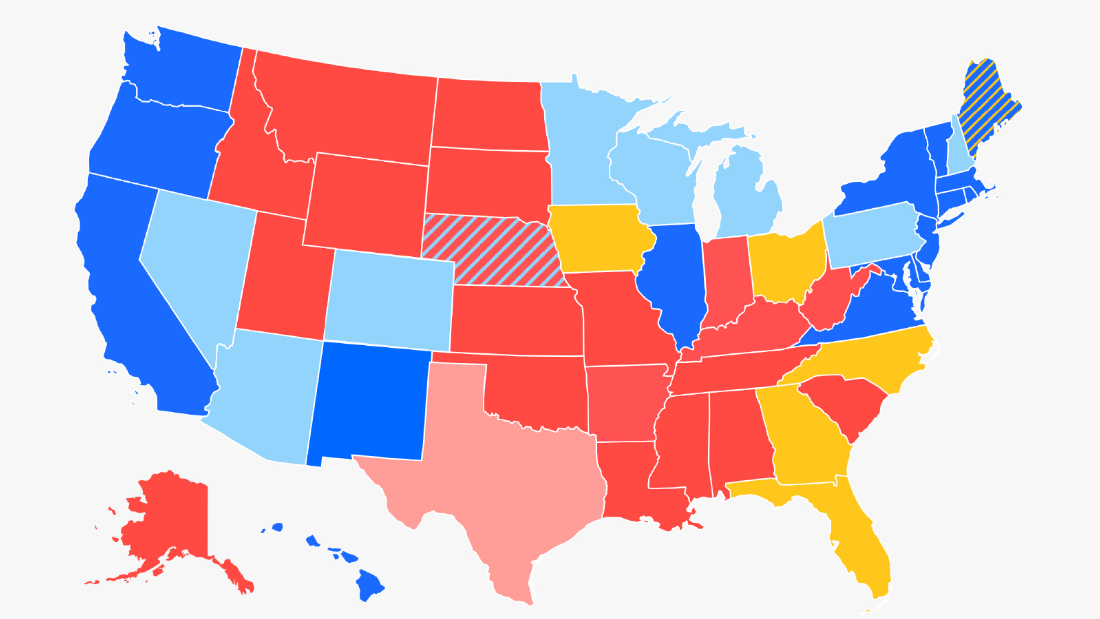
But what fewer people realize is just how dire the incumbent's electoral prospects actually are.
The best way to understand just how difficult it will be for Trump to win a second term is via the electoral map. And just how short he is of the 270 electoral votes he needs to win.
Start here: According to CNN's latest "Road to 270" rankings, Trump has 163 electoral votes solidly in his camp or leaning his way. Which means he has to find 107 electoral votes more in order to win a second term.
The next obvious place for Trump to turn is the states that CNN rates as "battlegrounds" -- where neither side has a clear edge. There are five states that fit into that category: Iowa, Ohio, North Carolina, Georgia and Florida. There's also a congressional district -- Maine's 2nd -- that CNN rates as a toss-up between the two parties. (Maine and Nebraska both award some of their electoral votes to the winner of each of its House seats.)
Add those five states -- and Maine's 2nd -- up and you get a total of 85 electoral votes. Give Trump a clean sweep of all of them and he's up to 248 electoral votes -- still 22 short of what he needs to win.
And giving Trump those battleground states is generous when you consider where the race stands in each one. Trump's largest average lead in the Real Clear Politics average in those states is .6% in Ohio. He has an average .4% edge over Biden in Florida and Georgia. In Iowa, Biden has a 1.4% average lead.
Could Trump sweep all of them? Sure! But there's also a plausible scenario where he loses all five. Or that the states split 3-2 or even 4-1.
But again, for the sake of argument, let's assume that Trump wins all five and the single electoral vote out of Maine's 2nd district. Where can he possibly find the other 22 electoral votes he needs?
Winning any of the three traditionally Democratic Rust Belt states -- Wisconsin (10 electoral votes), Michigan (16) and Pennsylvania (20) -- won't do it. Plus, polling in all three states suggests there's not much reason for optimism for Trump. Polls released Wednesday by The Washington Post and ABC News showed Trump trailing Biden by 17 points in Wisconsin and 7 in Michigan. Trump is closer in Pennsylvania; Biden's lead in Real Clear Politics' polling average is 3.8 points.
(Obviously, if Trump wins any two of those states, he would have enough electoral votes to win.)
If Trump can't win any of those three states, where can he look for the elusive 22 electoral votes? The pickings are slim. Arizona has long been a Republican state at the presidential level, but polling suggests Trump is in trouble there. And even if he wins it and its 11 electoral votes, Trump has only solved half of his problem. Ditto Minnesota, where Trump lost narrowly in 2016 and has talked about carrying this time. (And the polling in Minnesota looks even worse for Trump than in Arizona.)
Outside those two states, there's the 9 electoral votes in increasingly Democratic Colorado and the 6 votes in increasingly Democratic Nevada. Or the 4 electoral votes in New Hampshire, which Hillary Clinton by .3% in 2016 over Trump. But even if Trump won all 3 of those states -- he's not going to -- that's only 19 electoral votes total, meaning he would still come up short.
None of the above is to suggest Trump cannot win. Even if you believe he has a 10% chance of victory, that's still a chance. And as I often say, if someone said you had a 10% of dying if you went outside today, you would probably stay inside. Right?
What the electoral map and math do make clear, however, is just how many things need to not just go right but reverse their current trend lines for Trump to get to 270 or above. And it's a whole lot of things. Happening all at once. Counter to how they appears to be moving right now.
"right" - Google News
October 29, 2020 at 01:42AM
https://ift.tt/35HoMgf
Here's how tough the electoral math is for Donald Trump right now - CNN
"right" - Google News
https://ift.tt/32Okh02
Bagikan Berita Ini














0 Response to "Here's how tough the electoral math is for Donald Trump right now - CNN"
Post a Comment